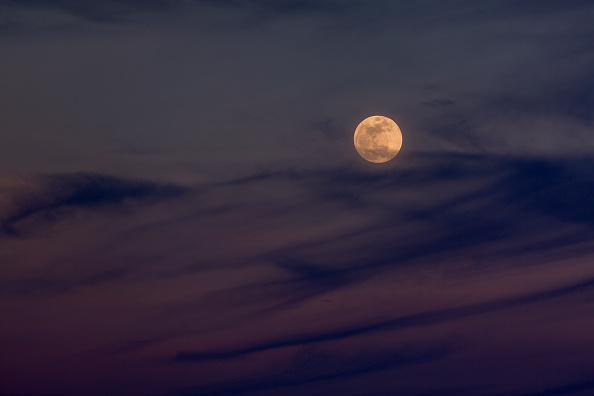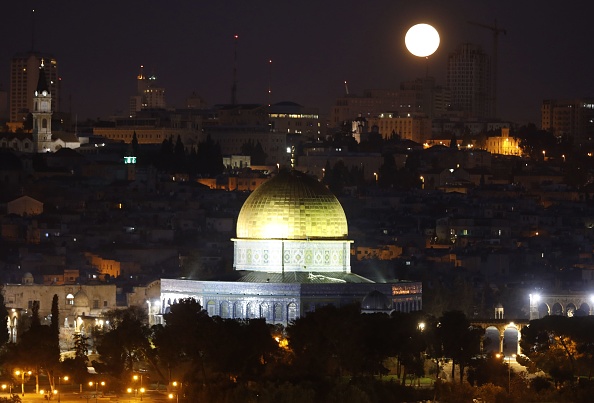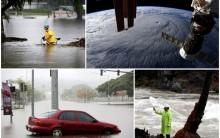1 of 5


The Moon rises over the Mojave Desert before becoming a so-called 'super blue blood moon' when it becomes totally eclipsed before dawn, on January 30, 2018 near Amboy, California. The 'super blue blood moon' is a rare 'lunar trifecta' event in which the Moon is at its closest to the Earth, appearing about 14 percent brighter than usual, and is simultaneously a 'blue moon', the second full moon in the same month, as well as a total lunar eclipse or 'blood moon'. Such a lunar event that hasn't been seen since 1866.
Credit: (Photo by David McNew/Getty Images)
2 of 5


The Moon rises over the Mojave Desert before becoming a so-called 'super blue blood moon' when it becomes totally eclipsed before dawn, on January 30, 2018 near Amboy, California. The 'super blue blood moon' is a rare 'lunar trifecta' event in which the Moon is at its closest to the Earth, appearing about 14 percent brighter than usual, and is simultaneously a 'blue moon', the second full moon in the same month, as well as a total lunar eclipse or 'blood moon'.
Credit: (Photo by David McNew/Getty Images)
Advertisement1
3 of 5
![The moon sets behind the city of Jerusalem early on January 31, 2018. A cosmic event not seen in 36 years -- a rare 'super blood blue moon' -- may be glimpsed today in parts of western North America, Asia. Super Blue Blood Moon,rare Super Blue Blood Moon,Eclipse 2018,Eclipse,Moon Eclipse,Super Blue Blood Moon pics,Super Blue Blood Moon images,Super Blue Blood Moon stills,Super Blue Blood Moon pictures,Super Blue Blood Moon photos,blood moon]()

The moon sets behind the city of Jerusalem early on January 31, 2018. A cosmic event not seen in 36 years -- a rare 'super blood blue moon' -- may be glimpsed today in parts of western North America, Asia.
Credit: (Photo by MENAHEM KAHANA/AFP/Getty Images)
4 of 5
![The moon sets behind the city of Jerusalem early on January 31, 2018. A cosmic event not seen in 36 years -- a rare 'super blood blue moon' -- may be glimpsed today in parts of western North America, Asia, the Middle East. Super Blue Blood Moon,rare Super Blue Blood Moon,Eclipse 2018,Eclipse,Moon Eclipse,Super Blue Blood Moon pics,Super Blue Blood Moon images,Super Blue Blood Moon stills,Super Blue Blood Moon pictures,Super Blue Blood Moon photos,blood moon]()

The moon sets behind the city of Jerusalem early on January 31, 2018. A cosmic event not seen in 36 years -- a rare 'super blood blue moon' -- may be glimpsed today in parts of western North America, Asia, the Middle East.
Credit: (Photo by MENAHEM KAHANA/AFP/Getty Images)
5 of 5
![The moon sets behind the city of Jerusalem early on January 31, 2018. A cosmic event not seen in 36 years -- a rare 'super blood blue moon' -- may be glimpsed today in parts of western North America, Asia, the Middle East, Russia and Australia. Super Blue Blood Moon,rare Super Blue Blood Moon,Eclipse 2018,Eclipse,Moon Eclipse,Super Blue Blood Moon pics,Super Blue Blood Moon images,Super Blue Blood Moon stills,Super Blue Blood Moon pictures,Super Blue Blood Moon photos,blood moon]()

The moon sets behind the city of Jerusalem early on January 31, 2018. A cosmic event not seen in 36 years -- a rare 'super blood blue moon' -- may be glimpsed today in parts of western North America, Asia, the Middle East, Russia and Australia.
Credit: (Photo by MENAHEM KAHANA/AFP/Getty Images)





